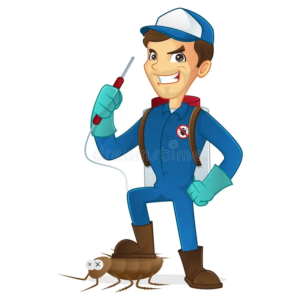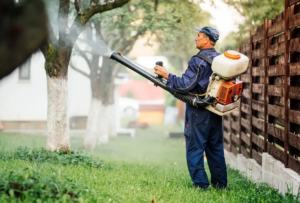Pests can damage your home and cause health problems for you, your family, and your pets. They can spread diseases such as hantavirus, leptospirosis, and Salmonella.
Prevention is key to keeping pests away. Some prevention strategies include removing clutter and sealing off spaces where pests can hide. Click the https://natureshieldpestsolutions.com/ to learn more.

The insect kingdom is the largest and most diverse group of hexapod invertebrates. It contains over a million described species and represents more than half of all animal types. Insects have a chitinous exoskeleton, a three-part body (head, thorax and abdomen) with three pairs of legs, compound eyes and a pair of antennae.
There are many ways to control insects in the garden, lawn or around the home. Some methods are more natural and others use pesticides, which can be harmful to children, pets, beneficial insects and the environment. The most important thing is to catch pests before they become a problem. It’s much less expensive to prevent an infestation than it is to treat a full-blown infestation.
Integrated Pest Management is the term used to describe a holistic approach to pest control. This includes prevention, monitoring, habitat modification and cultural, biological, mechanical and chemical controls. Cultural controls are changes to standard gardening or farming practices that reduce the likelihood of a pest problem. For example, planting species that are resistant to a particular pest or changing the timing of a given activity.
Another approach to controlling pests is through the introduction of predatory or parasitic insects. This can be as simple as releasing ladybugs to eat aphids or as complex as using microbe-based solutions engineered from bacteria to attack specific pests.
Physical control involves using traps, baits and barriers to deter pests. This is generally considered a safe method as long as the traps or baits are properly set, placed and maintained.
Biological control is an excellent way to manage pests naturally, and it can involve anything from introducing predatory or parasitic insects to the garden to releasing microscopic nematodes into the soil. These nematodes kill grubs, fleas, worms, ants, ticks and many other insects. The good news is that the nematodes are safe for children, pets and the environment, as they target only the bad bugs.
Chemical pesticides can be effective, but they are best used when necessary and based on regular, routine monitoring of pest populations. In addition, chemical products should be selected that are pest specific and do not kill beneficial insects, and only in the areas where pests are present. It is also advisable to apply pesticides at different stages in the pest’s life cycle, and to minimize spray drift.
Rodents
Rodents are a mammal order (Rodentia) that includes squirrels, chipmunks, rats, mice, porcupines, hamsters and guinea pigs. They have teeth adapted for gnawing, are active at night, and are opportunistic in their search for food, shelter and water. Rodents are considered pests when their activities damage buildings, create health hazards and destroy crops.
Rodents are known carriers of diseases that cause food poisoning and contaminate water supplies. They also transmit allergens and trigger asthma attacks. They are a significant fire hazard due to their propensity for chewing on electrical wires.
The most effective way to solve a rodent problem is with a multi-step approach that includes sanitation, exclusion and population control. Sanitation means keeping areas where rodents like to live and breed as clean as possible. Trash should be kept in tightly sealed containers, piles of brush or other debris should be removed, and shrubs and vines should be trimmed.
Exclusion is done by sealing cracks and crevices larger than one-quarter inch, especially those in foundations and crawl spaces. This is challenging because rats and mice can fit through gaps that are a fraction of their size. A trained pest control professional can locate and seal these entrance points.
Population control involves traps, baits and lethal controls. Baits can be placed in the form of tins, jars or heavy plastic. Traps can be set in attics, basements, crawl spaces and cabinets. A trained pest control professional can advise on the best trap types and placements. Lethal controls are used in conjunction with sanitation and exclusion to achieve the best results.
The most important thing to keep in mind about rodent infestations is that it’s never just one. Mice and rats are opportunistic, multiply quickly and can overtake a home if not managed properly.
Despite popular belief, household pets are not the answer to solving rodent problems. Although they may catch some, they are not able to reach all the places rodents hide, such as attics and crawl spaces. Moreover, if they are given rodent-repelling substances they can become accustomed to them and cease to work.
Diseases
Insect pests can be attacked by pathogens (bacteria, fungi, protozoans, viruses) that reduce their rate of feeding, slow their growth or even kill them. These pathogens are often specific to a single species of insect pest. Bacillus thuringiensis sprays, for example, use a protein produced by the bacteria to paralyze the gut of caterpillars, Colorado and elm leaf beetles and mosquito larvae. They are very safe for people and pets, and do not persist in the environment when used properly.
Integrated pest management, or IPM, is an ecosystem-based strategy that uses a variety of techniques to manage plants and insects. This includes monitoring, habitat manipulation, modification of cultural practices and the use of resistant varieties. If necessary, chemical controls can be used but only after monitoring indicates that pest populations are reaching damaging levels according to established guidelines. Pesticides are then applied only when the benefits of treatment outweigh the risks to beneficial and non-target organisms and the environment.
Many insect problems appear to be overnight events, but they usually take several weeks to develop and become obvious. Accurate identification, monitoring and understanding the life cycle of each pest is the key to preventing these problems before they start.
Safety
Regular pest control services are a proactive measure that protects the safety of you and your family. Pests can cause property damage and disease, including hantavirus, leptospirosis, Salmonella, and mosquitoes that carry diseases like malaria and Zika virus. Regular pest control can ensure that you don’t have rodents in your house, and that you don’t have mosquitoes breeding in your yard.
Pest control companies can also help you with home safety measures, including the use of natural pest predators and deterrents. Essential oils can discourage certain insects, such as peppermint oil for ants and lemon eucalyptus oil for mosquitoes. Placing sachets of these oils around the house can keep pests away without the need for toxic chemicals.
Many people prefer to rely on natural methods of pest control, which can be an environmentally friendly and health-conscious option. Organic and natural pest control methods also avoid the use of synthetic chemicals, which can pose risks to children and pets, and can be harmful to the environment.
These alternative approaches to pest control can be used at homes, offices, and schools. In addition, they can be effective in helping to maintain a pest-free environment for events, such as outdoor weddings.
In addition to these natural methods, some people choose to use chemical pesticides, which can be effective in reducing the number of pests at an event or in the home. In these cases, it is important to know how to properly use these products and to follow any safety guidelines that may be included with them.
A company that offers pest control can help with these safety measures by conducting an initial vulnerability assessment. This can include a site visit by an entomologist, who can evaluate the facility for the presence of pests and determine the best course of action to eliminate them. Depending on the type of pest and its environment, this might involve an initial treatment or specific preventive actions. For example, in an infestation of flies, a company might deploy nets or spray a combination of phenol and boron to kill them.

